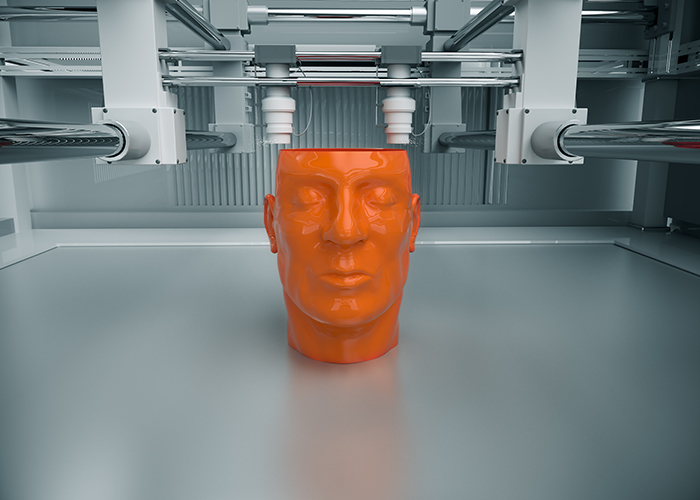Embrapa will test 3D bioprinting in agricultural research
Embrapa will test 3D bioprinting in agricultural research
Imitating nature in laboratories and manufacturing leaves, seeds, and even more complex structures of plants, animals or microorganisms could soon become a reality at Embrapa Genetic Resources and Biotechnology's Laboratory of Nanobiotechnology (LNANO), in Brasília, DF, Brazil. The recent approval of a project, as well as other related activities, will enable researchers to test biological activities in three-dimensional environments, that is, closer to reality.
The project leader, the Embrapa researcher Luciano Paolino da Silva explains that the technique used is called 3D bioprinting, a variant of 3D printing, a method to manufacture solid objects from a digital file containing spatial information and dimensional coordinates. The team intends to use the 3D bioprinting technology to create valid models and to test nanomaterials produced from biomolecules obtained from agricultural and forestry industry waste.
The creation of a 3D-printed structure is a relatively simple process and consists in depositing successive layers of a given material, such as metal, resin or polymers, until the object is ready. With 3D bioprinting, the difference is that the materials used are biological components like biomolecules and cells.
The technique is one of the most recent innovations in the field of biotechnology and synthetic biology, and the experience to be developed at LNANO will be a pioneering one in Brazil, Luciano Paolino asserts. “In traditional cultures, the cells are deposited on culture dishes in plain layers (2D), forming a single layer on which biological activity tests can be performed. With 3D bioprinting it will be possible to reproduce some of the three-dimensional conditions of livings beings”, explains the researcher.
According to Paolino, in the traditional cultures, the cells are generally presented in a disorganized arrangement, since they are outside their real space environment. In many cases, there is success at the in vitro stages and, at the time of the in vivo tests, the research shows flaws. By recreating environments that are closer to the reality of living beings, biological activity tests will become more precise and realistic.
The applications of 3D bioprinting, according to the researcher, could benefit different sectors of the economy, ranging from testing for the pharmaceutical industry to the mimicry of biological structures that would make it possible, for instance, to create artificial organs for transplants.
“When we master the model to multiply different types of cells, we will be able to build more complex structures, such as plant and animal organs, and even create structures that would work as if they were living organisms”, the researcher states.
With regard to agricultural research, an example of an application is the so-called “biofilms”, a set of aggregate microorganisms that are associated with countless infections. It will also be possible, for instance, to rebuild seeds with great similarity to natural ones. In the animal area, the applications vary from the creation of biological structures as a medium for active principles, e.g. pharmaceuticals and hormones, to the fabrication of structures that are similar to a uterus to maturate animal embryos for longer before implanting them in the receiving animals.
The stages of the project
The first stage of the project “Prototyping and fast fabrication of biofilm, tissue and organ imitations using 3D bioprinters for in vitro biological activity tests of bioactive compounds and nanosystems obtained from Cerrado plants” will be to acquire inputs for research, which will be partially funded by the Federal District Research Support Foundation (FAP-DF).
Once the inputs are secured, models will be shaped as three-dimensional files through a CAD software often used in architectural projects. Based on the digital project, the researchers will seek biological materials that are compatible with the technique to print the three-dimensional structure that will host the cells. At such stage, plant and animal tissue replacements and also colonies of microorganisms could be produced. The bioprinter will also allow the addition of culture media, such as nutrient for the cells, and move from the stage of bioprinting to biofabrication.
When the first prototypes are ready, analyses will be made to see whether the structures are ready to participate in 3D biological tests. “We intend to develop three-dimensional frameworks containing cells, and biological structures that allow us to mimic the conditions within a three-dimensional structure found in living organisms”, Paolino affirms.
Besides the laboratorial part, the project also stipulates the transfer of the technologies developed for the production sector, the training of undergraduate students in 3D bioprinting practices, and the dissemination of the knowledge thus generated to society.
.
| 3D printing debated at Embrapa since 2015 3D printing has already been the subject of at least three events organized by Embrapa Genetic Resources and Biotechnology. The first one, in June 2015, was a lecture with the designer Cícero Moraes, famous for having reconstructed Saint Anthony's face based on information about this skull. In the lecture, Cícero addressed the use of 3D graphic computing for human facial reconstruction and the possibilities to use the technology to the benefit of agricultural research. The second event was the lecture "3D printing applications in research", offered in May 2016 by Panacopy. On that occasion, the company brought a 3D printer and, during the lecture, built several plastic bearings. There was also a technical meeting with six Senai Innovation Institutes (ISI), in September 2016, in which one of the topics presented was “Laser and Advanced Materials and Nanocompounds”. The idea behind this meeting was to prospect opportunities for work in partnerships in the areas of biotechnology, genomics and nanotechnology. The first joint projects are already in discussion. |
Translation: Mariana Medeiros
Irene Santana (MTb 11.354/DF)
Embrapa Genetic Resources and Biotechnology
Press inquiries
irene.santana@embrapa.br
Phone number: +55 61 3448-4769
Further information on the topic
Citizen Attention Service (SAC)
www.embrapa.br/contact-us/sac/

